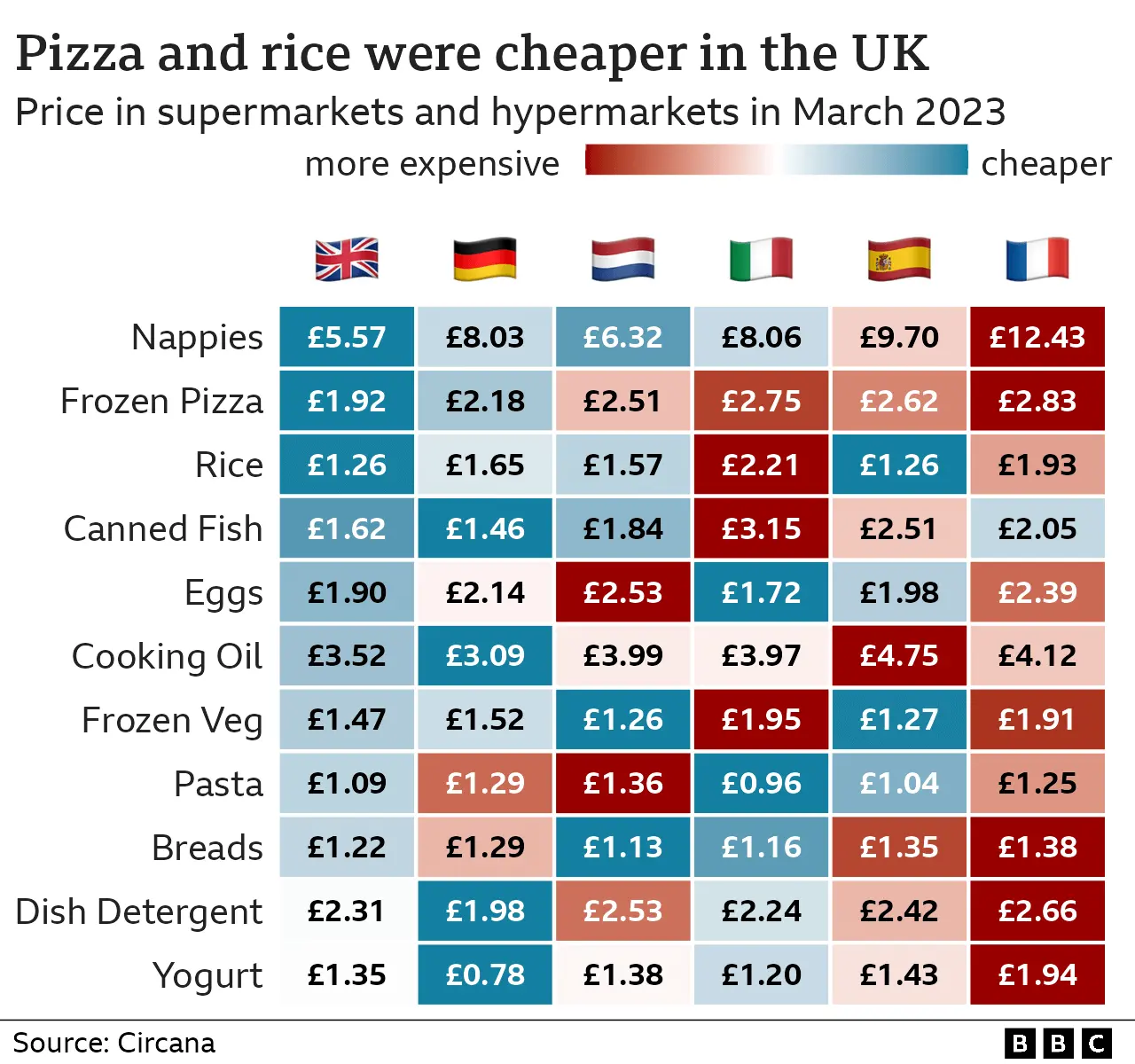Bread to loo roll: How UK prices compare to five EU countries
 Getty Images
Getty ImagesLoo roll, butter and ketchup are more expensive in the UK compared to some of our biggest European neighbours, research for the BBC suggests.
But the UK is the cheapest for nappies and frozen pizza, consumer analysts Circana found.
We compared the prices of 23 food and non-food items in France, Germany, the UK, Italy, Spain and the Netherlands.
When we added up the cost of buying them all, Germany came out as the cheapest and France the most expensive.
Our snapshot suggested that shoppers in the UK were typically paying £3.80 for loo roll when a comparable pack costs £2.66 in Italy and £2.87 in Germany.
Canned fish - like tuna - typically costs £1.62 in the UK but is as dear as £3.15 in Italy and £2.51 in Spain.
But the data also revealed that items like bread, eggs and cooking oil were all mostly cheaper in the UK.
'Untenable'
British households' budgets are being squeezed as overall food prices remain 19% higher than a year ago.
The main UK supermarkets have denied making extra profits from high prices and many have already been cutting the price of items like bread and butter. But Ananda Roy at Circana thinks retailers can go further.
"The prospect for UK households to continue paying more than they do already, even if inflation levels out, is untenable for many," said the global senior vice president of strategic growth insights.
"As commodity prices come down steadily, there is potential for retailers and brands to do more for hard-pressed consumers in the UK," added Mr Roy.

A recent survey from Oxford Economics found UK food costs were about 7% below the EU average. But that covers a huge variety of countries.
We asked Circana, which specialises in analysing consumer data, to look at some specific products in countries with the biggest, most developed economies in the European Union.
"Whilst in the UK we're experiencing higher prices for certain everyday items, at the same we're paying less than our European counterparts for others," said Mr Roy.
However, trying to compare the cost of food between countries is "super complex", said William Woods, who covers the European grocery market as an analyst for Bernstein.
There are a whole host of factors that can affect why food prices can differ.

The level of competition is important. In Germany, more than 40% of the market is made up by the discount supermarkets with cheaper own label products. There are also differences in eating habits and levels of food production to take into account.
The UK imports around 40% of its food. Mr Roy at Circana said this meant it paid a "buyer's premium" in what is now an increasingly volatile supply chain. Brexit hasn't helped.
Then there's politics. In other words, taxation, subsidies, and regulation. In France, for instance, greater protection for producers may be driving some higher food prices in stores, said Mr Woods.

Mr Roy and his team at Circana looked at the price per unit based on comparable pack sizes right across a category.
The price you see in the charts is the average for all the different types of product including branded and non-branded items. The cost in euros was then converted into pounds using the Bank of England's conversion rate.
The data is for March. In the UK, it doesn't include the discounters, Aldi and Lidl, which make up 17% of the UK grocery sector. But the research covers around 80% of the market in each of the other five countries.
This is a small snapshot. For instance, there's no fresh fruit and veg which was too difficult to compare because of seasonality, sizing and the amount of produce grown domestically.
The graph above shows the overall difference in price for the 23 products we looked at added together. Germany is the cheapest, £20 less than France which is way out in front. Our shop is third cheapest in this league table, fairly similar, in fact, with Italy, Spain and the Netherlands.
Andrew Opie from the British Retail Consortium (BRC) said: "This research confirms UK consumers benefit from a highly competitive market, delivering some of the cheapest groceries in Europe.
"We believe it underestimates the savings British consumers are making when buying staple food items, including fresh produce, as well as the value consumers can find by shopping around, another benefit of the strong competition in the UK market."
Food price inflation, the rate at which prices are changing, is affecting every European country.
Mr Roy said in recent weeks inflation had been easing in Germany, the Netherlands and Spain, where prices rose earlier than the UK. He expects the UK will follow suit over the next few months.

How can I save money on my food shop?
- Look at your cupboards so you know what you have already
- Head to the reduced section first to see if it has anything you need
- Buy things close to their sell-by-date which will be cheaper and use your freezer

